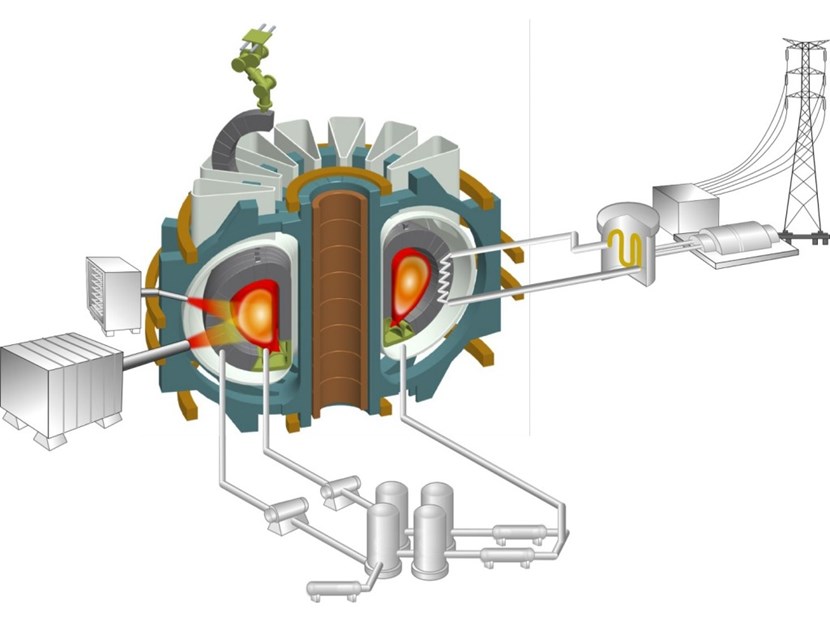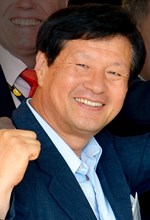
Korea's projected K-DEMO: a tokamak with a 6.65-metre major radius (as compared to ITER's 6.21 metres), a peak TF field of ~16 Tesla, and a TF field at plasma centre of ~7.6 Tesla.
Harnessing fusion energy in the 21st century is a lot like going to the Moon in the 1970s. At that time, as each manned flight project unfolded, another one was already in the plans. One half-century ago, the Mercury, Gemini and Apollo programs were the space equivalent of the fusion projects JET, ITER and DEMO.
In space exploration, as in fusion research, planning for the next step when the present one has just gotten underway is a necessity. This was the case with JET, which began operating two years before the ITER project was officially launched (1983), and it is happening now with ITER, with planning for the next stage device underway even before fusion experiments have started in 2027.
Hundreds of physicists and engineers throughout the world are now planning for DEMO, the generic name for a pre-industrial demonstration power plant that will bring all technologies to the level of performance, reliability and efficiency required for the production of electricity.
As was demonstrated during the recent international workshop held at the University of California, Los Angeles, on 15-19 October 2012, the time is now ripe for developing these ideas.
Korea (Pop. 49 million), which relies on imports for more than 90 percent of its energy needs, is among the countries that have embarked on the development of a preliminary concept for DEMO. The main parametres of the Korean DEMO ("K-DEMO") have already been defined and construction is expected to be completed in 2037.
Newsline sat with Kijung Jung, head of the Korean ITER Domestic Agency, to learn more.
R.A.
Newsline: Many countries and groups are currently working on a concept definition for DEMO. Would you say that Korea has now taken a decisive step in DEMO's direction?

Kijung Jung, head of the Korean ITER Domestic Agency, says that the actual R&D program for K-DEMO will be launched in 2014-2015 and that the pre-industrial demonstration power plant will be completed by 2037.
Kijung Jung: I would say that the decisive step was taken more than five years ago, when the Fusion Energy Development Promotion Law (FEDPL) was enacted. Korea was the first country in the world to lay a legal foundation for fusion energy development. It is within this framework that our government launched DEMO R&D planning project at the end of 2012 and we are expecting results at the end of June 2013. A preliminary validity review process and a main project validity review process will take place at the end of that year. We hope the actual R&D program will be launched in 2014-2015.
The recent workshop at UCLA made one thing very clear: there are about as many different potential DEMOs as there are countries involved. Does Korea already have an idea of what K-DEMO could be like?
Three options are being considered at this stage—machines with a respective major radius of 6.0 m, 6.65 m and 7.15 m. But the tokamak with 6.65 m major radius has become the main target for detailed study. The peak toroidal field is ~16 Tesla and the toroidal field at plasma centre is ~7.6 Tesla.
How will Korea's decision impact its participation in the ITER Project?
It will not. Korea will of course remain a strong partner in the ITER Project as it has been for the past ten years. Most of the engineering results from ITER Project will be incorporated into our K-DEMO and Test Blanket Module activity will be accelerated as a part of DEMO breeding blanket R&D.
According to media reports K-DEMO could be completed in the 2030s. Considering that ITER will begin deuterium-tritium operations in 2027 and that results from the ITER experiments have always been defined as necessary to the design of a DEMO, how do you reconcile the two project schedules?
The target completion date for K-DEMO is set at the end of 2037. Because there may not be enough nuclear data by that time, K-DEMO will also be used as a component test facility during its first operational phase, which will extend from 2037 to approximately 2050. During the second operational phase, which is planned to start in 2050, most in-vessel components will be replaced for full steady-state operation and electricity generation.
How will K-DEMO approach the plasma-facing materials issue?
The main issues for K-DEMO development are the divertor and the blanket issues. We will try to resolve these to the extent possible in collaboration with ITER Members. However, the issues will be finally resolved during the second K-DEMO operation stage.
Can you provide an estimate of K-DEMO's construction cost? How does it compare to the ~EUR 13 billion ITER price tag?
At present, it is premature to estimate K-DEMOs cost.



